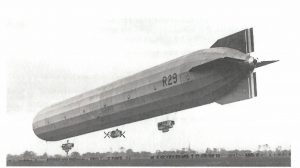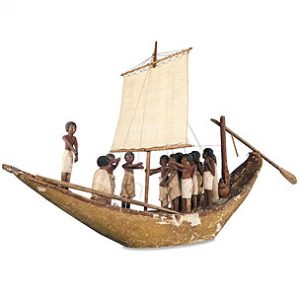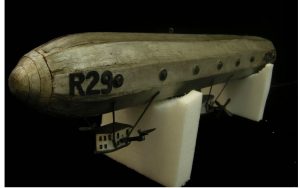October ’19
Model Airship

October’s ‘Object of the Month’ is a model airship that is part of Beamish Museum collections. The only information the museum had on the object prior to it becoming part of their collection is that it won second prize at Shildon show in 1919. Areas of missing paint show that the characters ‘R29’ were once attached in several places implying this is a model of the R29 airship. The airship was built in 1918 therefore the model must have been made in either 1918 or 1919.

The R29 airship was one of two British R23X airships that were built during the First World War. The first, the R27, was destroyed soon after it was built, but the R29 was much more successful flying over 8,000 miles during its life. It was completed in 1918 and was the only British rigid airship to see enemy action; it engaged in searching for German U-boats by flying overhead.

Making models of ships, traditionally sailing vessels, is something that is known to date back to ancient Egypt. As a hobby, it is a source of pleasure, enabling the maker to acquire new skills, demonstrating craftsmanship and creativity. Reconstructions of real ships is a common motive behind model making, commemorating the original vessel and during the 20th century, scale model making broadened to include aircraft.
Conservation

An initial surface clean was performed on the airship in order to remove surface dust and dirt; a conservation grade cleaning material known as smokesponge was used, which successfully removed the loose dirt from the surface. Although this treatment removed an initial later of dirt, it was clear there was still ingrained dirt on the surface. In order to remove this further layer of dirt and restore the brightness of the silver paint, a slight abrasive cleaner was used, which was sufficient to remove the dirt but did not damage the paint layer.

The aluminium carriages were surface cleaned using cotton wool swabs with deionized water in order to remove the dirt and iron staining. The metal struts holding the carriages in place were treated using 3-in-1 oil and swabs of 0000 grade wire wool in order to remove the corrosion. This method successfully removed the iron corrosion and revealed nickel plating that was still in tact. Following cleaning, both the wooden components and the metal components were coated with suitable solutions in order to help protect the surface from further deterioration.

It was decided that new pieces would be made for the model where there was firm evidence that additional material had originally been present. These included the round attachments along the hull, the top and bottom pieces of the carriage, the missing nose/tail cone, the insignia and the propellers.

The missing wooden components were replicated using balsa wood, as this was easily distinguishable from the original wood used and it was easy to carve and shape. All pieces were colour matched to blend with the original material and were adhered to the model using an acrylic copolymer adhesive. Although the original insignia was cut from a sheet of possible rubber, the decision was made to also carve replica insignia from balsa wood as this would allow the additions to be easily distinguishable from the original. These were again colour matched and adhered using an acrylic copolymer.

To replicate the missing propellers, a mould was first made using the existing half propeller. From this ten casts were made , which would make up the remaining five propellers on the model. The replicas were cast using plaster of Paris to distinguish from the original and were colour matched. The propeller shafts were carved using lime wood, as they needed more strength than the balsa wood could supply and the plaster of Paris propellers were then adhered to the shafts, and finally the original model using an acrylic copolymer.

Stay tuned for next month’s object!
